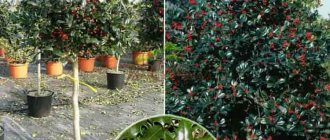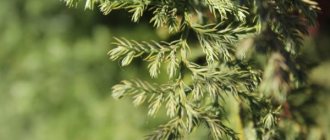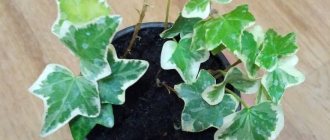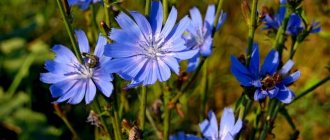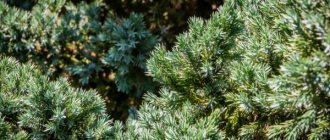Botanical description of Holly
Holly (lat. Ilex) is a deciduous or evergreen shrub or tree from the Holly family. The Latin name of the plant means Stone Oak.
Budleya - planting and care in open ground
Medlar - beneficial properties, how to grow at home
Holly flowers are rather inconspicuous. They are very small and light in color. Flowers form in the spring in the axils of the leaves. Very often, male and female flowers are formed on different trees, and therefore, in order for the plant to bear fruit, it is necessary to plant the male tree next to the female one. The fruit of Holly is a stone fruit.
Young Holly branches are pointed in shape, and the leaf blades are simple alternate, whole or jagged at the ends. Holly Holly leaves have sharp thorns. They are unusually prickly and retain their sharpness for a long time even on fallen old leaves, so fallen leaves should be removed very carefully so as not to injure your hands.
Holly grows both in tropical forests and in temperate climates - in fir-spruce or cedar-spruce forests.
The value of Holly among different nations
Holly has been known since ancient times. For example, the Druids symbolized this plant with the sun, and on gloomy, stormy days, the ancient Celts brought young Holly branches into the house so that the sun would emerge from behind the clouds faster.
Holly branches were also used to decorate the walls of houses back in Ancient Rome during the Saturian celebration, which fell in winter. With the adoption of Christianity, a new holiday appeared - Christmas. And today, in many countries, Holly branches are used to weave Christmas wreaths and decorate homes with them.
Common Holly Types
The genus contains about 400 species. The most common types used in park and garden culture are the following.
Holly Holly (Ilex Aquifolium)
The plant is evergreen. The tree can grow up to 15 meters in height, forming a dense pyramidal crown. The shoots are short and spreading. The leaf blades are ovoid in shape and have short petioles. The edges of the leaves are wavy, with large prickly spines. Small white fragrant flowers are held on short stalks. The fruits are spherical in shape and bright red in color.
Holly holly is a shade-loving, frost-resistant crop. It must be taken into account that it grows very slowly. Lifespan – 1 century. Has female and male varieties.
Female varieties - “Handsworth New Silver”, “Golden King”, “Amber”. Men's uniform - "Silver Queen".
Crenate holly (Ilex сrenata)
It is a shrub or low tree. Grows up to 3-5 meters. It grows slowly. It retains its haircut for a long time, so it can be used as a low-growing shrub in parks and gardens.
The leaves are shiny, dark green. The length of the sheet plates is 10-30 mm, width - 10-17 mm. The edges of the leaves are jagged and may be prickly. The flowers are dioecious, white, with four petals. The fruit is a drupe.
Holly Altaclerensis (Ilex Altaclerensis)
It is a fairly hardy, frost-resistant variety. Belongs to the evergreen species. The leaves are smooth, without thorns. Ideal for growing in city parks as it tolerates gas pollution well. Has female and male varieties. The female variety is “Belgica Aurea”, “Wilsonii”, the male variety is “Hodginsi”.
Whorled Holly (Ilex Verticillata)
Decoratively attractive appearance. The height of the bush is 3 meters. It is especially beautiful in winter, when the branches are covered with bright orange drupes. Grows in the shade, prefers moist soil rich in humus. Begins to bear fruit at the age of 16. The fruits ripen in late September - early October.
How to care?
Young hollies are planted in the spring, and it is preferable to purchase seedlings with ZKS, because This plant does not tolerate transplantation well. The tree trunk circle is mulched with any natural material and timely watering is ensured, since hollies react painfully to even short-term drying out of the soil. Adult specimens are more hardy in this regard. Annual fertilizing is done from the 3rd year from the time of planting, choosing compositions for evergreen or decorative deciduous crops.
► Types and varieties of hawthorn
Holly grows slowly. The first flowering and fruiting occurs at 14-18 years of age. Fragrant, but inconspicuous small flowers appear in late May - June on last year's annual growths, so pruning is carried out in the second half of summer. In spring, only damaged or dry shoots can be removed. Holly lends itself well to shaping pruning, which is why trimmed hedges and topiary figures are so often made from it. But this is the prerogative of gardeners in USDA zones 7-9, where the climate itself favors these amazing plants.
! For variegated varieties (examples of varieties in the photo below), you need to remove shoots with regular green leaves, maintaining the original color.
In the garden, hollies are most often used as tapeworms, often with unusual topiary haircuts, but they combine perfectly in compositions with hydrangeas, euonymuses, conifers and other shade-tolerant shrubs and trees.
Growing by cuttings
This method allows you to preserve the decorative forms of the plant. Cuttings are taken from semi-lignified shoots of the current year. Their length is 4-5 cm, and each cutting must have 1-2 internodes. The cuts are made at an angle: the lower one is under the lower bud, the upper one is above the upper one. The prepared sections are immediately planted in a container filled with the following substrate: a layer of humus about 10 cm thick, then a layer of sand about 3 cm. The cuttings are placed in the soil to a depth of 1.5-2 cm. The planted cuttings must be protected from bright sun and constantly sprayed. They take root in 2-4 weeks.
Holly propagation
In nature, holly seeds are spread by forest birds that eat the berries from the bushes. But this method of propagation can only be used for green-leaved species plants, since varietal characteristics in this case are not inherited. In addition, holly seeds require one and a half years of stratification, which also does not increase the desire to use this method.
The easiest way to get daughter plants from a holly variety you like is to propagate by layering. To do this, in the spring, select one or several lower young branches, make several shallow cuts in the bark at the future point of contact with the soil, bend them and place them in a prepared shallow trench. Then all that remains is to secure the branches using available materials, such as electrodes, and sprinkle with earth. The tree trunk circle must be mulched and kept evenly moist. After the roots have formed, the young holly is separated from the mother plant and planted in a permanent place.
Holly cuttings involve a number of difficulties, the main of which is maintaining a high level of humidity during the entire rooting period, which is 3-4 months. For cuttings, select semi-lignified shoots with a “heel” up to 10 cm long. The sections must be treated with growth stimulants: Heteroauxin, Kornevin and others. The soil substrate for rooting is made up of equal parts of peat and coarse sand.
Holly Care
Caring for Holly is in many ways similar to caring for shrub plants. This, of course, includes pruning, loosening, mulching the tree trunk, fertilizing, etc.
Article on the topic: Galip nut - beneficial properties, description
Pruning, bush shaping
Because Holly grows very slowly, it needs pruning to form a compact bush. This procedure must be carried out in the spring. Diseased, frozen shoots are removed. Many designers create a curly haircut that lasts throughout the season. Holly is an excellent solution for creating a beautiful topiary.
Plant shading
In the spring, you need to pay attention to how open and sunny the place where the Holly grows is. As noted above, this culture is not light- and sun-loving, so if necessary it will need to be shaded. Otherwise it will get burned.
Holly should be fed at the beginning of the season. To do this, a layer of compost mixed with complex mineral fertilizers is poured around the trunk circle of the bush (tree). With rain, the fertilizer will gradually be absorbed into the soil and feed the root system of the plant.
Shelter for the winter
Young plants, even if they are winter-hardy, need shelter. The bushes can be covered with spruce branches or fallen leaves. The tree trunk circle is insulated with sawdust or peat.
Holly in landscape design
This beautiful plant has excellent uses, like other shrubs in the natural garden. It provides food for birds in winter thanks to its fruits, which are stored on the branches until the next flowering begins. And it is thanks to the birds that holly reproduces in the wild: by eating the berries, they spread the seeds contained in them almost everywhere.
Gardeners know that the young shoots of this plant are the most intrusive weeds. Holly holly lends itself well to topiary. Therefore, designers very often use it to obtain beautiful topiaries. Bonsai enthusiasts also love working with this shrub.
Planting and caring for holly
Holly is a tree or deciduous evergreen shrub most common in tropical and temperate climates. Since ancient times, the branches of this plant have been used to strengthen the entrance to a home. It was believed that holly could ward off evil spirits.
Baltic, Celtic, Slavic, Scandinavian peoples used the branches of this shrub. Holly branches can be found on cards, packaging, wreaths and garlands. Few people know, but it belongs to the poisonous plants.
Description of the species
Holly, a photo of which can often be found on Christmas cards, belongs to the family of the same name. It has about four hundred varieties, distributed in both temperate and tropical regions. Few people know that all its species are poisonous plants. Photos and names of them can be found in any manuals on plant growing.
These are evergreen shrubs or trees with spiny, jagged, or less often entire leaves. All representatives of dioecious plants have small, axillary flowers and berry-like fruits - drupes, which look very appetizing, but are inedible: they are all poisonous plants.
Description of the plant
Holly has the following characteristics:
- Crown . Most often narrow, cone-shaped. The branches in it are densely located and there are quite a lot of them. The bark of the tree is smooth, silver-gray in color.
- Leaves . Mostly simple. Their shape can be different: ovoid, oblong-elliptical and others. The color is mostly dark green. But there are species where the leaves have 2 colors: dark green and yellow (edging). The top of the leaves is shiny, the bottom is matte. The edges are covered with numerous denticles and wavy.
- Flowers . They are inconspicuous, usually light in color. Their diameter is small, 6–8 mm.
- Fruits . They are called drupes. Can be of various colors: black, yellow, white, red, orange. The fruits have a round shape, their diameter is 7–10 mm. They remain on plants until spring. The fruits, at first glance, seem appetizing, but they cannot be eaten as they are poisonous.
The most common types
There are about 400 species of this plant in total, but we will look at three of them.
holly
Found in Asia Minor, Southern Europe, and North America. This is an evergreen pyramidal or spherical tree, reaching a height of up to 15 meters. Its lifespan is up to 100 years. It grows in nature even in the North Caucasus. Outwardly, it looks like a Christmas tree.
Its branches are spreading and short. The crown is dense, oblong or pyramidal. The leaves have an oblong-ovate shape with wavy edges.
Holly holly flowers are white, fragrant, small. They will remain on the branches for 14 days. Then they will be replaced by bright red fruits, the size of which can reach up to 1 cm. They remain on the stalks throughout the winter.
This species can easily be located in the shade, is resistant to frost, and tolerates temperatures down to minus 22 degrees below 0. The plant, located in central Russia, is not able to winter, so it is grown only in winter gardens.
It is worth knowing that holly is the variety through which other varieties were developed. It is a dioecious plant with a deep root system. Fertile neutral soil is suitable for growing this species. It prefers either full shade or partial shade. It perfectly withstands smoky, polluted air.
Crenate holly
This plant is native to Sakhalin and the Kuril Islands. This species can be either a tree up to 7 m high or a shrub. The latter is less common.
Crenate holly stands out for its dense greenery, reminiscent of boxwood in appearance. Bred in Japan. In this country it is a dwarf topiary shrub.
Holly meserva
This is a hybrid of common, wrinkled and Korean holly. It is especially common in Russia, as it can withstand frost well. This species has many varieties, the leaves of which are darkish, blue-green in color.
Photos and names of holly varieties
There are many varieties of this representative of the Eurasian flora. For example, the crenate, also called Japanese, subspecies is an evergreen plant, the height of which reaches only two and a half meters. It has small and rounded leaves.
Another variety is the meserva holly, which is a hybrid that has many varieties with very dark bluish-green leaves. The purely “male” Blui Prince is considered an excellent pollinator for its “brothers”. Golden and Blue Princesses are also same-sex. Some varieties, including Blue Maid, have both female and male flowers on the same plant. They have ordinary green foliage, not as showy as, for example, Blue Angel, since it lacks the characteristic metallic sheen.
Most varieties have red fruits, although some, such as Golden Princess, have yellow fruits.
Many people think that hollies are only evergreen, but this is not true. In the family of the same name there are also deciduous subspecies. The decorative whorled holly is especially interesting in appearance. It is native to the northeastern regions of North America. It gets along well with other hardwoods. Whorled holly can only be found in moist soils, such as swamps or along the banks of streams.
Rules for planting holly
This plant loves shade, rich, light and moist soil. A substrate made from the following components is perfect for growing: humus, peat, sand, clay mixed with activated carbon. Drainage is also necessary. Its thickness must be at least 3 cm.
Holly holly requires cross-pollination. Therefore, you should have several such plants on the site. You can combine varieties by planting male and female trees next to each other.
It should not be planted in a place where there is a lot of sunlight. The plant may suffer from this, so the best place for it is where there are no bright rays. However, there are bicolor species that have variegated leaves. In order for them to retain their color, these plants should be planted in a place with bright light.
Holly does not tolerate excessive heat. In the summer, it is recommended to move it to a room where the air temperature will not exceed 20 degrees Celsius. Only young plants should be replanted every year. After that, as needed, every 3-4 years. In the spring it is simply moved to a larger container.
Main methods of reproduction:
- seeds;
- cuttings. This method is more common. Semi-lignified cuttings 10 cm long are required. To root them at the end of summer, the cuttings are placed in a peat-sand mixture and placed in a place where there is no direct sunlight and high temperature. After the roots have appeared, the cuttings are planted in separate containers.
Since holly is a beautiful tree, it is often grown in pots. At home, the tree needs to be replanted in the spring every 2 years into a larger pot.
Reproduction by cuttings and layering
To propagate holly, layering or cuttings are most often used. This method is faster and more effective than propagation by seeds. The stages of propagation by cuttings are as follows:
For planting, select annual shoots that have not yet become lignified and cut cuttings 10–12 cm long.
- All leaves are removed from the lower third of the cutting.
- The tips of the shoots are dipped into the rooting agent solution and placed in a container of water until roots appear.
- You can use special cups for rooting. Seedlings should be kept on a windowsill in a shaded place.
With proper care, seedlings will be obtained in 2-3 months. Cuttings that were germinated in water are additionally planted in pots with soil. It will be possible to plant young plants in open ground only next spring. During the warm season, young bushes have time to mature and grow powerful roots. However, for the winter they need to be sprinkled with peat and covered with spruce branches.
If holly is already growing on the site, it can be propagated using layering. To do this, the branches are tilted and lightly sprinkled with earth. The procedure for such reproduction will be as follows:
- The leaves on the shoot are removed, after which it can be secured with metal brackets and sprinkled with soil.
- After 2-3 months, the cuttings will take root and begin to form new shoots.
- Such a seedling is left to grow throughout the year. The following spring, the shoot is separated from the mother bush and transplanted to a new location.
Reproduction by seeds in the holly's natural habitat takes 1.5 years. On a garden plot, you can wait 2-3 years for seedlings to appear. Since the plant is dioecious, it requires artificial pollination.
Care instructions
Holly holly does not require excessive attention. Both sandy and clay soils are suitable for it. The main thing is that they are waterproof and humus is present.
The plant does not like drought. In summer, when it is hot, it should be watered abundantly. By winter, the amount of watering should be reduced to moderate, preventing the soil from drying out. Pruning should be done after fruiting has ended.
In spring, young plants should be covered to protect them from sunlight. From spring to autumn, once a month you should feed the tree with liquid complex fertilizer, diluted in the following ratio: 30 ml per 10 liters of water.
Article on the topic: Blood-red hawthorn - beneficial properties, description
How to Plant Holly
The plant does not require special attention when growing. It is best to plant it in shaded areas; it does not like direct sunlight. The area where the shrubs will be planted must be protected from drafts and wind.
The soil should be prepared light and well moistened. It is very important to ensure good drainage. In heavy soil, holly has difficulty surviving winters and grows very poorly.
Planting young bushes in the ground is carried out according to the following rules:
- The soil in the pot with the seedling is thoroughly watered before planting. This will soften the earthen lump, after which it can be easily pulled out.
- Planting holes are prepared in advance on the site. Their sizes should be 2-3 times larger than the size of the pots with seedlings.
- Drainage is poured into the bottom of the hole. The layer thickness should be at least 3-4 cm. Broken brick, small crushed stone and other materials with similar properties are suitable for this purpose.
- A mixture of soil and humus is poured onto the drainage. Each hole will require approximately half a bucket.
- The seedling is placed vertically in the hole, the roots are straightened and sprinkled with soil. The root collar is slightly buried, then the roots will not be exposed after the soil settles.
The seedlings need to be watered abundantly, but moisture should not be allowed to stagnate in the root system.
Features of cultivation
When growing holly, you may encounter some difficulties:
- Fungal diseases. In this case, purple spots will appear on the leaves. The fungus appears due to the fact that there was not enough watering and the soil was highly acidic. Or the plant did not have enough essential nutrients - potassium, nitrogen, phosphorus.
- Holly can be affected by late blight, which will lead to root rot and death of the tree. If this disease is discovered, the plant should be immediately destroyed and the soil around it should be treated with disinfectants.
- Holly does not tolerate aridity and heat well. He prefers cool places.
Holly holly is not a very fastidious plant. Knowing the characteristics of this plant, variety, planting and care rules, no special difficulties should arise. It is important to follow all the recommendations, and only in this case the plant will grow beautiful and pleasing to the eye.
Paraguayan holly (Ilex paraguariensis)
A shrub or tree up to 15 meters in height, whose age sometimes reaches 100 years. The whole world has heard about the healing power of the leaves of the “green gold” of South America, and Paraguayan mate tea occupies a leading position among caffeine drinks.
Table of contents
Flower formula
In medicine
Paraguayan holly leaves have long been used to prepare a tonic drink - mate tea. Mate tea is a traditional drink of Latin Americans, but recently it has been rapidly gaining popularity all over the world, including in the CIS countries. Mate is in the lead even with green tea. Its unique composition does not cause heart palpitations or disrupt the sleep cycle like caffeine in black or green tea. Among the active components of the drink is special, harmless caffeine (mateine). It does not contribute to addiction, and its strength is that it helps the human body get rid of addiction to true caffeine.
Paraguayan holly has: cardiotonic, tonic, antiseptic, diuretic, immunomodulatory, stimulating, antirheumatic, antitumor properties.
The mate drink helps lower blood pressure, dilate blood vessels, improve mood, improve the functioning of the cardiovascular system, strengthen memory, the nervous system, increase concentration, improve digestion, remove excess fluid from the body and stimulate the adrenal glands, strengthening the body's defenses.
Pagarvai tea is used in the treatment of obesity, since the drink suppresses the feeling of hunger. The active substances of mate have a laxative, anorectic and diuretic effect. With regular consumption of the drink, the functioning of the heart and stomach improves, large blood vessels and capillaries dilate, metabolism is normalized, memory and the nervous system are strengthened.
The drink made from Paraguayan holly leaves contains approximately 196 vitamins and mineral active substances, which is many times more than green tea! The huge boost of energy given by mate can last for as long as 10 hours.
Contraindications and side effects
Mate should not be drunk by those for whom theophylline or theobromine is dangerous, people with high acidity and kidney disease, especially those with a tendency to deposit salts (stones, sand). Paraguayan tea is not recommended for children, pregnant women and nursing mothers.
In cooking
In addition to the world-famous tonic and healing mate tea, the bark of the plant is used in cooking. Crushed bark is an excellent seasoning with a specific aroma for fish and meat dishes.
The fruits of Paraguayan holly, unlike all parts of the plant, are poisonous.
In cosmetology
Recent studies of the components of yerba mate extract indicate its anti-inflammatory and antioxidant properties. The use of Paraguayan holly is acceptable in anti-aging products, anti-inflammatory emulsions and ointments (acne therapy), and in products for spa treatments (creams, masks, wraps). Since it is found to have high UV filters, yerba mate is used in sunscreens and after-sun creams.
Classification
In the modern classification, Paraguayan holly belongs to the Angiosperms department, the Dicotyledonous class, the Holly species, and the Holly family (lat. Aquifoliaceae).
Botanical description
Paraguayan holly is an evergreen shrub or tree with smooth whitish bark and fairly hard wood. The branches of the plant are spreading, forming a pyramidal crown. The plant grows very slowly, living up to 50-100 years. Some trees reach 100 meters in height, but in general they usually grow up to 15 meters. Cultivated specimens are pruned to form neat bushes up to 1.5 meters in height. Leathery, glossy, obovate-shaped leaves are placed alternately on the shoots. The edges of the leaf blades are jagged.
From late May to mid-June the plant enters the flowering stage. The flowers are axillary, dioecious, on short pedicels, arranged in bunches at the base of the leaves. The petals of the corollas are greenish-white. After flowering, around September, drupes of bright red color and spherical shape are formed, which remain on the branches all winter. Holly propagates by seeds and vegetatively (cuttings). The formula of the Paraguayan holly flower is ♂L4+T4.
For optimal growth and development of Paraguayan holly, the ideal conditions are tropical and subtropical climates, where air humidity should be with precipitation of 1500 mm per year. On plantations, shrubs are harvested 5 years after planting using cuttings.
Spreading
The Paraguayan holly is native to Brazil, Uruguay, Argentina and Paraguay. It grows wild in the Mediterranean, Europe, Asia Minor, North America, and along the shores of the Atlantic Ocean. It is found in deciduous and coniferous forests, in semi-shaded or well-lit areas. Prefers high soil moisture.
The plant is cultivated in Latin America and the tropics of Asia. The Misiones province in Brazil is especially famous for its large plantations of Paraguayan holly. The territory of mate occupies more than 65 thousand hectares here. There were attempts to grow plants in other regions of the world, but the climatic conditions were not suitable for optimal growth and development of holly.
Procurement of raw materials
For medicinal purposes, young shoots, leaves, bark of mate, as well as the underground part of the plant - the roots - are harvested. The leaves have particular value and beneficial properties in the spring and summer. The process of preparing raw materials for mate tea is quite lengthy. Since Paraguayan holly grows in regions with high humidity, parts of the plant must be thoroughly and thoroughly dried to prepare the drink.
Leaves are collected no more than once every three years in order to allow the tree to recover and replenish its energy. Holly is dried in two ways. If the goal is to obtain green mate tea, then the raw materials are dried using modern hot air dryers at a temperature of 60°. To give the tea leaves a golden hue, dry the twigs over an open fire. The crushed plant, dried in accordance with the standards of mate preparation technology, must necessarily contain natural dust. Well-dried branches and leaves need long-term storage (at least a year) in bags, after which they are crushed into powder. Thus, the dried plant retains its medicinal properties.
Article on the topic: Crow's eye four-leaf - useful properties, description
Chemical composition
Based on the results of repeated studies of the composition of the plant, it turned out that Paraguayan holly is a unique source of vitally important and necessary active components for life. Resins, vitamins C, A, B1, B2, B6, E, choline, riboflavin, pantothenic, ursolic, nicotinic acids, cholene, chlorophyll, inositol, magnesium, iron, potassium, manganese, tannins, glycosides, syringin, inbortin, calcium , sodium, silicon, potassium, cellulose, hydrochloric acid, phosphates - and this is not a complete list of the active substances of Paraguayan holly. This set of substances is extremely rare in one plant specimen and is considered a unique composition. Drupes contain coloring substances - rutin and ylexanthin.
A strong infusion of mate has a slight sweetish taste and contains some xanthine alkaloids. This includes theobromine, caffeine, theophylline.
Pharmacological properties
In homeopathy, powdered leaves, flowers and young shoots of Paraguayan holly are used as an antifever and diuretic for rheumatic pain, dropsy, as a diaphoretic, antipyretic, expectorant for colds, bronchitis, pneumonia. The diuretic effect of mate is due to the fact that it contains xanthine compounds.
Preparations from Paraguayan holly are recommended to reduce the destructive effects of neuroses and depressive states, since the treatment suppresses the release of adrenaline. As a result, sleep is normalized, insomnia disappears, and symptoms of fear, emotional imbalance, and tension are relieved.
Pharmacological agents based on Paraguayan holly have astringent, stimulant, diaphoretic, diuretic, antifebrile, choleretic, antioxidant, cardioprotective, antiallergic, antisclerotic effects on the human body. Mate extracts and decoctions are used as a central nervous system stimulant.
In pharmacology, the basis of drugs is holly leaves. When consumed orally, the fruits cause mild intoxication of the body, in particular diarrhea and severe nausea. In case of poisoning, gastric lavage is prescribed.
Mate is used in the treatment of gastrointestinal diseases, helps eliminate inflammation of the gastric mucosa, regulates cholesterol levels, activates bile secretion and liver function. Tonic tea perfectly satisfies hunger and is considered an effective complementary component of a weight loss diet. A healing drink made from holly leaves is especially effective against stress and depression, reduces excitability, and promotes normal sleep regulation.
Used to prevent diseases of the heart muscle and blood vessels, reduces blood pressure. The components of preparations from Paraguayan holly actively supply active oxygen to the bloodstream, due to the presence of chlorophyll. Mate relieves fatigue well and prevents the formation of lactic acid in muscles after intense physical training.
A real drink made from holly leaves resembles green tea in appearance, but its taste is different. Mate contains herbal notes with a slight bitterness and a sweet aftertaste. There are no analogues to tea made from holly leaves. In order to get the maximum of useful substances and vitamins from the Indian drink, it is recommended to drink mate warm, but not hot. Brew in hot water, without bringing to a boil. The dried leaves give the drink a beautiful golden hue, the stems give the maximum amount of vitamins, and the light dust is evidence of the quality and good drying of Paraguayan tea.
Using the mate drink during an illness makes it easier, speeds up the healing process, and also stimulates the body's defenses and removes unnecessary toxins and waste. Holly preparations are excellent antiseptics and help increase the number of leukocytes in the blood.
Thanks to clinical studies of mate, its ability to stimulate the adrenal glands and have a comprehensive effect on the nervous and endocrine systems of the body has been proven. Has a mild laxative, diuretic effect.
Use in folk medicine
The bark in the form of poultices and compresses is applied to the affected areas of the skin for bone fractures, as it relieves pain well. A decoction of the bark is an effective cough suppressant and has a strong diuretic effect.
Holly drupes are poisonous to the human body, but can also be beneficial. Ancient Indians used holly fruits as an antidote for poisoning, as a laxative and an emetic. In modern medical practice, the fruits are used to stop bleeding. Drupes contain the toxic component ilicin, so excessive, uncontrolled consumption can cause poisoning (just 25 fruits eaten can lead to fatal consequences).
Historical reference
Residents of Latin America have long considered holly a sacred plant, and the ritual of drinking a tonic drink takes them from 1.5 to 2 hours. Mate is a traditional drink that is consumed at the height of business meetings and diplomatic receptions, social events and home tea drinking. Refusal of the drink leads to the disappointment of the hospitable hosts, and is also considered an insult and ignorant behavior of those who do not want to share in the ritual of sacred tea drinking.
Tea from young shoots and dried leaves of Paraguayan holly is drunk throughout the day. The bitter drink mate is consumed in the morning, the sweet terere in the afternoon, and the sweet drink in the evening. Bitter tea without sugar is a men's drink, sweet mate is consumed by women and children. Orange juice, milk, mint and other ingredients are added to the tea depending on personal preference.
The name “mate” itself comes from the Indian word mati. This is what the Guarani Indians called a vessel (“calabas”) made from an ordinary pumpkin. The vegetable is used for drinking tea, as well as preparing the drink itself. Locals call mate "kaa", in Europe the name Paraguayan tea is better known. In pharmaceuticals, the Latin American plant acquired the name Matefolium. In the world, mate is a popular drink, known as the “green gold” of South America.
Paraguayan tea is covered in myths and legends of its origin. According to the legend of the ancient Guarani, the god Paya Sharume, with fair skin and blue eyes, once dominated their land. It was he who taught the population religion, medicine and agriculture. Mate is considered a divine medicinal plant because it was given by the god Sharuma himself.
The French naturalist Augustus de Saint Hilaire explored the mate thickets in the Paraná basin back in 1822. Since that time, the leaves of the plant have been successfully used as a healing and tonic drink. Ancient Spanish and Portuguese sailors got rid of seasickness and scurvy by regularly taking mate.
Use in folk medicine
Almost all above-ground parts of holly are used for medicinal purposes. Infusions and decoctions from them have healing properties:
- For diseases of the upper respiratory tract, an infusion of leaves is taken as an expectorant and diaphoretic.
- A powder is prepared from the flowers and leaves and used as an antipyretic and anti-inflammatory agent for rheumatism or fever.
- The leaves also have antiseptic and cardiotonic properties.
- Compresses and poultices are prepared from holly bark, which are used for fractures and bruises. This remedy relieves pain well.
- A decoction of the bark is taken as a diuretic and for severe coughs.
- The berries of the plant in small doses have an astringent, laxative and emetic effect.
The leaves and berries of any type of holly contain a toxic substance - ilicin. Eating large quantities of berries can cause serious poisoning, even death.
Signs of poisoning may include dizziness, nausea, sudden loss of strength, vomiting, and diarrhea. When these symptoms appear, immediately rinse the person’s stomach and give a cleansing enema. Be sure to call emergency services.
To prepare a universal infusion from holly leaves, you will need 2 tablespoons of crushed raw materials. It is poured with 150 ml of vodka and infused for 7 days in a dark place. The resulting product is filtered and taken 25 drops, dissolved in 50 ml of water. Drink the infusion 3 times a day 30 minutes before meals.
To restore strength in case of physical and mental fatigue, pour boiling water over a tablespoon of leaves and leave for half an hour in a thermos. The strained mixture is drunk three times a day, 1/3 cup between meals.
Tonic mate tea is prepared from the leaves and young shoots of the Paraguayan holly. The leaves contain a large amount of caffeine. This tea has a positive effect on the human condition. And another healing drink is prepared from the leaves of the Chinese holly - kudin. It improves digestion and stimulates the stomach, increases body tone, reduces cholesterol and lipids in the blood, helps get rid of excess weight, and protects against radioactive exposure.
It should be remembered that all types of holly contain poisonous components, so treatment should be carried out under the supervision of a doctor.
